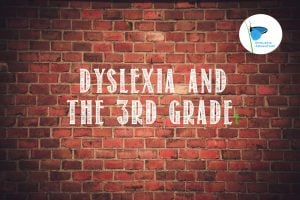 If you’re not aware if the ‘3rd Grade Wall’, you can get blind-sided.
If you’re not aware if the ‘3rd Grade Wall’, you can get blind-sided.
A recurring theme that we hear about when we interview accomplished dyslexic men and women is the trouble and failure (often grade retention) that happens in the 3rd grade. Why? What’s the big deal about the 3rd grade?
From Time Magazine,
“Take a guess: What is the single most important year of an individual’s academic career? The answer isn’t junior year of high school, or senior year of college. It’s third grade.
What makes success in third grade so significant? It’s the year that students move from learning to read — decoding words using their knowledge of the alphabet — to reading to learn. The books children are expected to master are no longer simple primers but fact-filled texts on the solar system, Native Americans, the Civil War. Children who haven’t made the leap to fast, fluent reading begin at this moment to fall behind, and for most of them the gap will continue to grow.”
If that weren’t enough to cause concern, research from Hunter College:
“Educators and researchers have long recognized the importance of mastering reading by the end of third grade. Students who fail to reach this critical milestone often falter in the later grades and drop out before earning a high school diploma. Now, researchers have confirmed this link in the first national study to calculate high school graduation rates for children at different reading skill levels and with different poverty rates. Results of a longitudinal study of nearly 4,000 students find that those who do not read proficiently by third grade are four times more likely to leave school without a diploma than proficient readers. For the worst readers, those who could not master even the basic skills by third grade, the rate is nearly six times greater. While these struggling readers account for about a third of the students, they represent more than three-fifths of those who eventually drop out or fail to graduate on time.”
But also listen to present-day venture capitalist Scott Sandell’s recall his memories (or lack of memories) in the 3rd grade.
So what’s the truth? It may not have been that the teacher didn’t like Scott, but her frustration about his lack of progress was getting the best of her.
What often happens to dyslexic students in the 3rd grade is that they’re unable to make the leap between simple reading of single syllable phonics words to new lower frequency multiple syllabic words that that infuse 3rd and 4th grade texts. The problem can be invisible to all but to the children themselves because they make educated guesses and clues from teacher instructions and friends’ help so that it looks as if reading comprehension is fine…but it’s not. At home, children may appear to beautifully read aloud favorite stories, but if you were to point to certain words at random on the page, it becomes clear that they aren’t reading but rather repeating back memorized books that they had heard before.
Some dyslexic students may adopt ‘guess and go’ strategies or reading the shapes of words to get them through the 3rd grade, but this may only postpone challenges and significantly hamper them in the learning of technical and academic vocabulary that’s very important for subjects like Science or proper names and place names in Literature and Geography. What often needs to happen at this age is explicit instruction and practice with word parts and strategies for decoding long words.
We’ll do a a deep dive of this topic along with specific suggestions for practice in our next Premium post.














